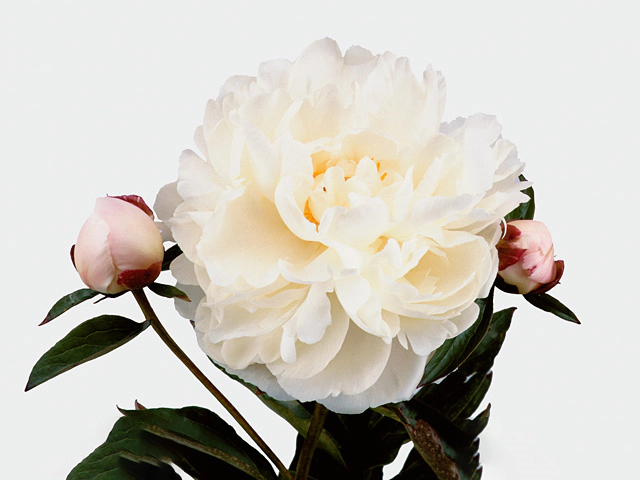Paeonia (Lactiflora Grp) 'Gardenia'

| Leaf tip | Pointed/acute |
| Flower type | Double (pleniflorous) |
| Flower scent | Different; Normal |
| Leaf type | Foliage leaf |
| Winter hardness | Good (USDA-zone 5, 6) |
| Flower color | White-white-155B |
| Soil fertility | Special demands |
| Inflorescence | Single-flowered |
| Structure (tissues) | Woody |
| Light conditions | Sunny; Semi-shades |
| Plant, growth type | Erect |
| Toxicity (if consumed) | Fairly |
| Moisture requirements | Moist; Well-drained |
The Paeonia (Lactiflora Grp) 'Gardenia', commonly known as the Gardenia Peony, is a breathtaking flower that will add elegance and beauty to any garden. This stunning peony variety has several unique characteristics that make it a favorite among gardeners.
One of the distinguishing features of the Gardenia Peony is its pointed or acute leaf tips. The leaves are foliage leaves, adding a lush green backdrop to the beautiful blooms. This particular peony belongs to the double or pleniflorous flower type, meaning it has multiple layers of delicate petals, creating a voluminous and luxurious appearance.
While most peonies have a similar floral scent, the Gardenia Peony surprises with a different yet equally pleasant fragrance. It adds a fragrant touch to any garden or floral arrangement. The flower color is a pure and pristine white, categorized as white-white-155B according to the Royal Horticultural Society color chart.
In terms of its growth and structure, the Gardenia Peony is an erect plant, reaching an average height of around 2 to 3 feet. Its woody tissues contribute to its overall sturdy structure. This peony thrives in USDA hardiness zones 5 and 6, indicating its good winter hardiness and ability to withstand colder temperatures.
When it comes to light conditions, the Gardenia Peony is adaptable. It prefers sunny spots but can tolerate partial shade. This makes it a versatile addition to any garden, as it can thrive in a variety of lighting conditions.
However, it is important to note that the Gardenia Peony has special demands when it comes to soil fertility. It requires well-drained soil with special attention to moisture levels. The peony prefers moist conditions but can suffer if the soil becomes waterlogged. Providing suitable soil conditions will ensure the plant's healthy growth and prolific blooming.
One consideration to keep in mind is the toxicity of the Gardenia Peony if consumed. While not highly toxic, it is advisable to prevent pets or children from ingesting any parts of the plant to avoid any potential adverse effects.
Overall, the Gardenia Peony is a stunning and sought-after flower with its beautiful white blooms, unique fragrance, and graceful foliage. Its adaptability to different light conditions and good winter hardiness make it a desirable addition to any garden. With proper care and attention to its soil and moisture requirements, this peony will reward gardeners with its captivating beauty year after year.
Market availability index by month:
| Jan. | Feb. | Mar. | Apr. | May | Jun. | Jul. | Aug. | Sep. | Oct. | Nov. | Dec. |
|---|---|---|---|---|---|---|---|---|---|---|---|
| 1 | 1 | 1 | 1 | 4 | 3 | 2 | 1 | 1 | 1 | 1 | 1 |